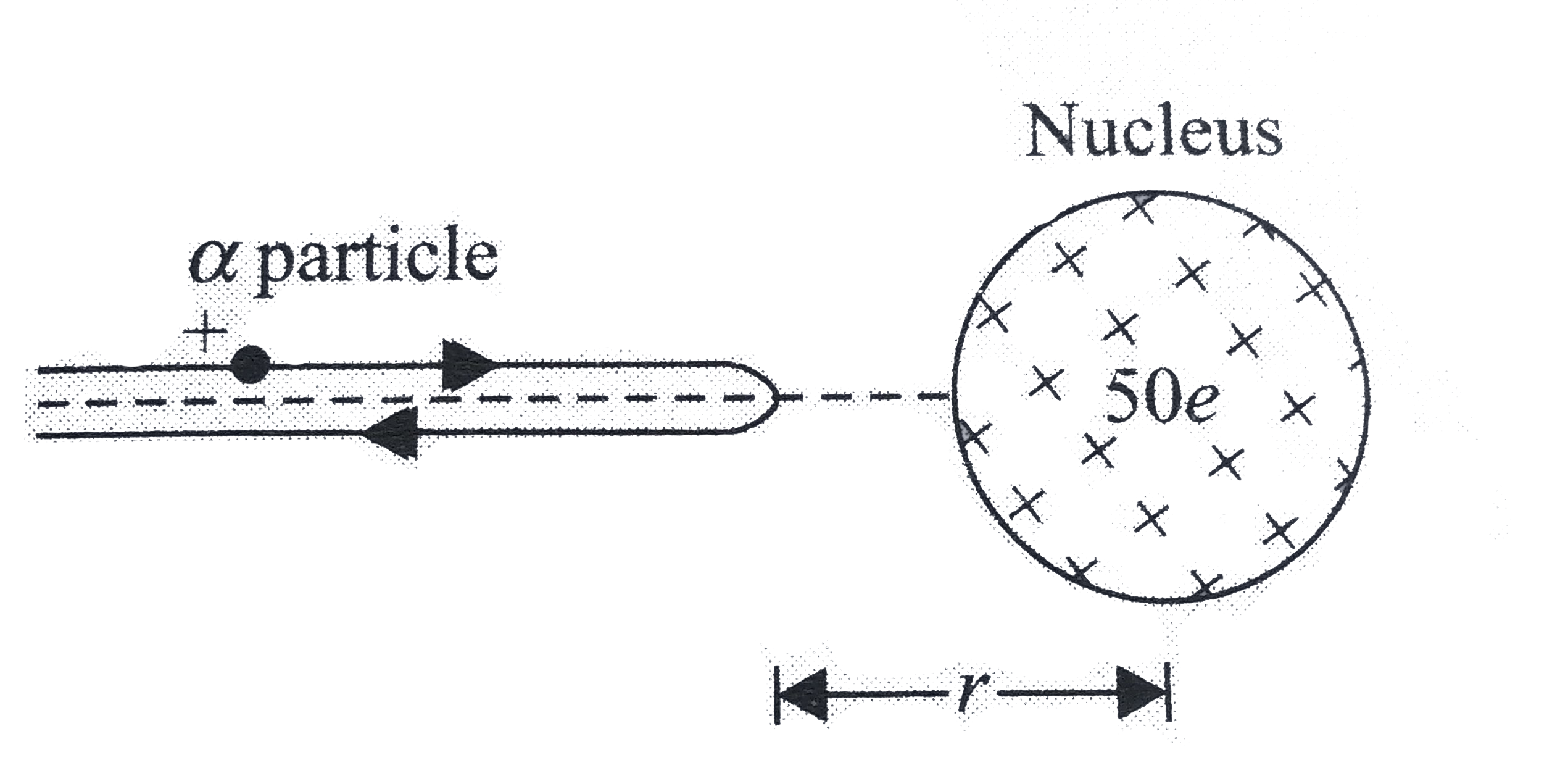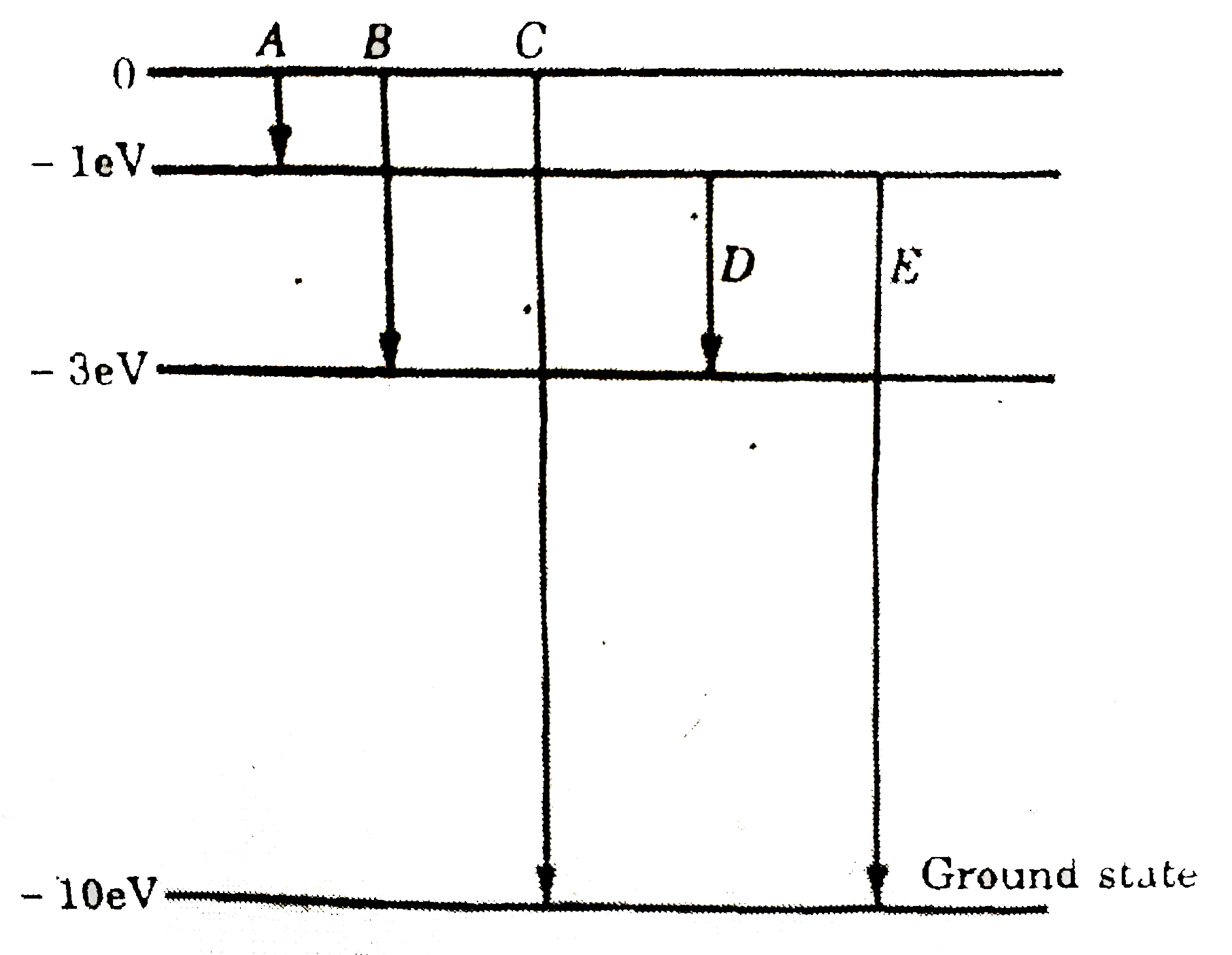Example from DHANPAT RAI & CO PHYSICS Chapter 2 ATOMS, NUCLEI AND MOLECULES for Class 12
| Class 12 | PHYSICS |
| Chapter | ATOMS, NUCLEI AND MOLECULES |
| DHANPAT RAI & CO PHYSICS | Example |
| Medium | English |
| Academic Year | 2023-2024 |
Question 4
An α-particle after passing through a potential difference of 2×106V falls on a silver foil. The atomic number of silver is 47. Calculaye (i) the kinetic energy of the α-particle at the time of falling on the foil (ii) the kinetic energy of the α-particle at a distance of 5×10−14 m from the nucleus and (iii) the shortest distance from the nucleus of silver to which the α-particle reaches.View SolutionQuestion 7
A projectile of mass m, charge Z', initial speed v and impact parameter b is scattered by a heavy nucleus of charge Z. Use angular momentum and energy conservation to obtain a formula connecting the minimum distance (s) of the projectile form the nucleus to these parameters .show that for b=0, s reduces to the closest distance of approach r0. View SolutionQuestion 8
for scattering by an inverse square law field (such as that produced by a charged nucleus in Rutherford's model), the relation between impact parameter b and the scattering angle θ is given by
b=Ze2cotθ/24π∈0(12mv2)
(a) What is the scattering angle for b=0?
(b) for given impact parameter, b, does the angle of deflection increase or decrease with increase in energy?
(c) What is the impact parameter at which the scattering angle is 90∘ for Z=79 and initial energy=10MeV?
(d) Why is it that the mass of the nucleus does not enter the formula above, but its charge does?
(e) for a given energy of the projectile, does the scattering angle increase or decrease with decrease in impact parameter?View SolutionQuestion 18
The total energy of an electron in the first excited state of hydrogen atom is -3.4 eV.
(a) What is kinetic energy of electron in this state?
(ii) What is potential energy of electron in this state?
(c) Which of the answers above would change if the choice of zero of potential energy is changed?View SolutionQuestion 31
A free electron of energy 1.4eV collides with a H+ ions. As a result of collision, a hydrogen atom in the ground state is formed and a photon is released. What is the wavelength of the emitted radiation ? In which part of the electromagnetic spectrum does this spectrum lie ? Give ionisation potential of hydrogen =13.6eVView SolutionQuestion 46
The neutron separation energy is defined to be the energy required to remove a neutron form nucleus. Obtain the neutron separation energy of the nuclei .20Ca41 and .13Al27 from the following data : m(.20Ca40)=39.962591u and m(.20Ca41)=40.962278u
m(.13Al26)=25.986895u and m(.13Al27)=26.981541u View SolutionQuestion 66
The normal activity of living carbon -containing matter is found to be about 15 decay per minute for every gram of carbon. This activity arises form the small proportion of radioactive .6C14 present with the ordinary .6C12 isotope. When the organism is dead, its interaction with the atmosphere which maintains the above equilibrium activity, ceases and its activity begins to drop. from the known half life (=5730years) of .6C14, and the measured activity, the age of the specimen can be approximately estimated. This is the principle of .6C14 dating used in archaeology. Suppose a specimen from Mohenjo - daro gives an activity of 9 decays per minute per gram of carbon. Estimate the approximate age of the Indus Valley Civilization.View SolutionQuestion 72
The Q value of a nuclear reaction
A+b=C+d is defined by Q=[mA+mb−mC−md]c2 where the masses refer to the respective nuclei. Determine form the given data the Q value of the following reactions and state whether the reactions are exothermic of endothermic.
(i) .1H1+.1H3→.1H2+.1H2
(ii) .6C12+.6C12→.10Ne20+.2He4
Atomic masses are given to be
m(.1H2)=2.014102u,m(.1H3)=3.016049u,m(.6C12)=12.000000u,m(.10Ne20)=19.992439uView SolutionQuestion 73
Consider one of the fission reactions of U235 by thernmal neutrons :
.92U235+n→.38Sr94+.54Ce140+2n
The fission fragments are, however, not stable. They unaergo successive β−decays unit .38Sr94 becomes .40Zr94 and .54Xe140 becomes .58Ce140. Estimate the total energy released in the process. Is all that energy available as kinetic energy of the fission products (Zr and Ce)? You are given that
m(U235)=255.0439amu, mn=1.00866amu m(Zr94)=93.9065amu, m(Ce140)=139.9055amuView SolutionQuestion 77
Suppose India has a target of producing by 2000 A.D., 100,000 MW of electric power , 10 percent of which is to be obtained from nuclear power plants. Suppose we are given that, on average the efficiency of utilisation (i.e., conversion to electric energy) of thermal energy porduced in a reactor is 25%. How much amount of fissionable uranium would our country need per year at the turn of this century ? Take the heat energy per fission of U235 to be about 200 MeV. Avogadro's Number N=6.023×1023mol−1.View SolutionQuestion 81
It is proposed to use the nuclear fusion reaction,
.21H+21H→42He
in a nuclear reactor 200MW rating. If the energy from the above reaction is used with a 25 per cent efficiency in the reactor, how many grams of deuterium fuel will be needed per day?(The masses of .21H and .42He are 2.0141 atomic mass units and 4.0026 atomic mass units respectively.)View SolutionQuestion 82
Consider the so called D-T reaction (deuterium-tritium fusion) .1H2+.1H3→.2He4+n
Calculate the energy released in MeV in this reaction from the data
m(.1H2)=2.014102u,m(.1H3)=3.016049u
(b) Consider the radius of both deuterium and tritium to be approximately 2.0fm. what is the kinetic energy needed to overcome the Coulomb repulsion between the two nuclei? To what temperature must the gases the be heated to initiate the reaction?View Solution
 .
.
